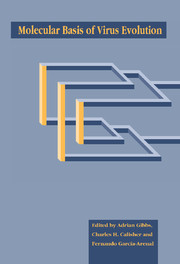Book contents
- Frontmatter
- Contents
- List of contributors
- Editors' preface
- Conference participants
- 1 Introduction and guide
- Part I The impact of viral diseases
- Part II Origins of viruses and their genes
- Part III Sources of virus variation
- Part IV Molecular interactions of viruses and their hosts
- 10 Viruses as ligands of eukaryotic cell surface molecules
- 11 The influence of immunity on virus evolution
- 12 Effect of variation within an HIV-1 envelope region containing neutralizing epitopes and virulence determinants
- Part V Viruses, hosts and populations
- Part VI Case studies of viral taxa; their systematics and evolution
- Part VII Techniques for viral systematics
- Index
12 - Effect of variation within an HIV-1 envelope region containing neutralizing epitopes and virulence determinants
Published online by Cambridge University Press: 04 May 2010
- Frontmatter
- Contents
- List of contributors
- Editors' preface
- Conference participants
- 1 Introduction and guide
- Part I The impact of viral diseases
- Part II Origins of viruses and their genes
- Part III Sources of virus variation
- Part IV Molecular interactions of viruses and their hosts
- 10 Viruses as ligands of eukaryotic cell surface molecules
- 11 The influence of immunity on virus evolution
- 12 Effect of variation within an HIV-1 envelope region containing neutralizing epitopes and virulence determinants
- Part V Viruses, hosts and populations
- Part VI Case studies of viral taxa; their systematics and evolution
- Part VII Techniques for viral systematics
- Index
Summary
Introduction
The third variable domain (V3) of the external envelope glycoprotein (gpl20) of the human immunodeficiency virus type 1 (HIV-1) contains determinants of virus cytopathicity, cell tropism and virus infectivity (Cheng-Mayer, Shioda & Levy, 1991; Chesebro et al, 1991; Freed & Risser, 1991; Hwang et al, 1991; Ivanoff et al, 1991; Takeuchi et al., 1991; de Jong et al, 1992; Fouchier et al, 1992). Antibodies binding to the virus V3 region block cell-free virus infectivity and cell-to-cell spread of virus (Goudsmit et al., 1988; Palker et al, 1988; Rusche et al, 1988). Recent evidence suggests that the ability to induce V3-specific antibodies may be pivotal to vaccine efficacy. Berman et al (1990) and Girard et al (1991) have demonstrated that chimpanzees can be protected by active immunization from infection by virions. Subsequently, Girard and colleagues have shown that the vaccination protocol used previously (Girard et al, 1991) protected against challenge with infected cells (M. Girard, personal communication). Both Berman and Girard suggested that antibodies to the virus V3 region contributed to protection, a notion that was corroborated by the fact that monoclonal antibodies to the V3 domain protected chimpanzees against infection by HIV-1 virions (Emini et al, 1992). Variation of the HIV-1 envelope protein and of the V3 domain in particular, may control HIV-1 pathogenesis and vaccine efficacy by modulating virus virulence and sensitivity to neutralizing antibodies.
Two major forms of variation are observed during the course of infection: one general and one V3-specific. Host-to-host transmission has a major impact on one form of variation, but hardly one on the other, resulting in very important principles of V3 diversification in the population.
- Type
- Chapter
- Information
- Molecular Basis of Virus Evolution , pp. 165 - 178Publisher: Cambridge University PressPrint publication year: 1995



